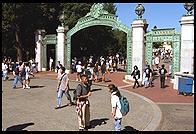
Academically Adrift
a review by Philip Greenspun; June 2011
Site Home : Book Reviews : One Review

|
Academically Adrifta review by Philip Greenspun; June 2011
Site Home : Book Reviews : One Review |
Academically Adrift: Limited Learning on College Campuses
is a report on research by two sociologists, Richard Arum and Josipa Roksa. The book provides some answers to the following questions:
With all of this investment in education, why don't American workers earn more than they used to? Median hourly earnings, adjusted for inflation, are actually lower than they were in 1973, a time when few Americans benefited from a college education. If Americans with college degrees were well-educated, shouldn't that lead to higher demand from employers for their services?
The most obvious explanation is that American college graduates are not well educated: "from 1992 to 2003 the percentage of college graduates proficient by various literacy measures was relatively low, and by two of those three indicators competency declined (prose 40 to 33 percent; document, 37 to 25 percent; and quantitative, 31 percent at both time points)." How much would one expect an illiterate college graduate to be worth?
At the heart of the book is an analysis of data from the Collegiate Learning Assessment (CLA), which requires students to synthesize data from various sources and write up a report with a recommendation. It turns out that attending college is a very inefficient way to improve one's performance at this kind of task. After three semesters, the average college student's score improved by 0.18 standard deviation or seven percentile points (e.g., the sophomore if sent back into the freshman pool would have risen from the 50th to the 57th percentile). After four years, the seniors had a 0.5 standard deviation improvement over the freshman, compared to 1 standard deviation in the 1980s.
The first answer provided by Arum and Roksa is that full-time students don't spend very much time on academics when in college, down from 40 hours per week in the early 1960s to 27 hours per week today. Time studying fell from 25 hours/week in 1961 to 13 hours/week in 2003.
Much of the growth in statistical income inequality within the U.S. is attributable to three factors: (1) we decided to give most of our new wealth to a handful of people on Wall Street, (2) the SEC prevents public company shareholders from influencing top executive pay (instead determined by the CEO's golfing buddies on the board), and (3) we decided to welcome a lot of poorly educated immigrants into the U.S. Economists have found that if one removes people who work in the financial services industry and looting public company managers, the remaining pool of Americans has roughly the same income distribution as in earlier decades (see this presentation by Daron Acemoglu, for example, this paper by Philippon and Reshef, and this essay by Esther Duflo). So the perceived societal shift is mostly about two government policies, one that socializes losses on Wall Street while allowing bank employees to privatize any gains, and one that enables public company executives to transfer shareholder wealth into their own pockets. Another factor is that, unlike countries such as Australia and New Zealand, the U.S. admits immigrants without regard to their ability to earn an income. An immigrant who speaks limited English and who did not have a good education back home is not likely to be a high earner.
One would expect increased access to a college education to reduce income inequality and, with the dramatic increase in the number enrolled in college, provide a dramatic push against the trends cited above. The authors of Academically Adrift quote Americans going back to the 19th Century saying that education will be the great equalizer for the children of the poor. Measured by the CLA, this belief turns out to be false. The more educated the parents, the better the college student will do on the CLA. Students whose parents have a bachelor's degree will, at the end of two years of college, score only about as well as freshmen whose parents have a professional or graduate degree. Students whose parents never went to college will graduate with lower CLA scores than freshmen whose parents are doctors.
I can't figure out why academics are so drawn to sorting people by skin color, but Arum and Roksa are no exception. They can't resist dividing up the CLA scores by the race of the student and displaying a bar chart showing that African-Americans are hopelessly behind Hispanic, Asian-American, and White students. Then they're not content to let the bar chart speak for itself: "African-American students not only entered higher education with lower CLA scores than their white peers, they also gained less over time. During their first two years of college, white students gained 41 points while African-American students gained only 7 points. ... As a consequence, the gap between African-American and white students increased over time." Then the authors resort to statistical gymnastics to try to account for the racial gap in terms of parental education, income, and other family backgrounds. But no matter how they cook the numbers, they conclude that skin color is a strong predictor of performance on the CLA and also on whether or not attending college will change a student's performance on the test.
At least as far as the CLA goes, college turns out to be a great way of increasing inequality among Americans: "Students in the top 10 percent of the sample, for example, improve their CLA performance by more than 1.5 standard deviations from the fall of their freshman year to the end of their sophomore year. This would translate into a 43 percentile gain, indicating that if these freshmen entered higher education at the 50th percentile they would reach a level equivalent to the 93rd percentile of an incoming freshman class by the end of their sophomore year."

The authors of Academically Adrift found that colleges are, for the most part, indifferent to whether or not professors are effective teachers. To the extent that colleges work teaching quality into decisions about promotion and pay they do so by considering student evaluations. Which professors do students evaluate highest? Those who assign the least reading and give the highest grades (researched by Valen Johnson is cited). So every professor has a big incentive to make his or her class easy and to give every student an A.
[My own solution to this problem is "Stop grading your own students" in "Universities and Economic Growth?".]

College major is a big predictor of CLA score as well as how much that score will improve during four years of college. Education and business majors are hopeless, possibly explaining the poor performance of American public schools as well as why our economic growth has slowed despite a greatly increased number of business people with formal training in business. Education and business majors do poorly on the CLA test as freshmen and their ability to think and write scarcely improves during college. Science and math majors, on the other hand, do the best and improve the most. Business and education majors have lower ACT/SAT scores when entering college, but their performance on the CLA is worse than predicted by their poor SAT scores.
The book summarizes two surveys of U.S. employers. In the first survey, the employers said that 16 percent of four-year college graduates "excel in written communication and 28 percent in critical thinking/problem solving." A second survey found that employers believed 26 percent of college graduates were competent to write and 22 percent were able to think.

The authors cite no evidence that anyone is interested in improving the amount of learning by undergraduate students in American colleges and universities. Colleges have made, literally, trillions of dollars by warehousing students for four years and giving them a diploma. Nobody is proposing that students graduating college be given an impartially administered test to assess their capabilities and therefore, aside from the handful of people who read this book, nobody is in a position to know just how poorly educated American college graduates are. On page 125, the authors themselves admit that it would not serve any current institutional interest if students learned more. Nonetheless, proceeding from their unsupported assumption that someone might care about improving outcomes, the authors provide some guidance as to how learning might be increased.
The authors propose a big increase in workload for faculty that will simultaneously be accompanied by a likely pay cut and promotions denied. Faculty should be spending more time with students and therefore less on the research that will get them promoted and funded. Faculty should be assigning much more reading and writing for each class, which is a demonstrated way to earn lower marks in the student satisfaction surveys that are used by colleges as a factor in tenure and promotion.
The authors note that improving K-12 education will help students enormously once they get to college. They decry the emphasis on standardized testing in K-12 and say that K-12 schools need to take more responsibility for "youth socialization and moral education" so that students will come out "loving learning". They provide no concrete suggestions for how this is to be accomplished and their own numbers show that school teachers who majored in education are essentially illiterate. They don't say how Jane Teacher who learned nothing in college and who cannot digest information and write a simple essay is supposed to instill in young people a love of the learning that she herself failed to achieve. They don't mention the fact that it would be illegal for most school systems to hire the science, math and humanities majors who outperformed the education majors.
The authors suggest that colleges should spend vast sums of money on new dormitories so that more students can live on campus. They don't consider the possibility that the money might be better spent on lab/office-style spaces in which student could work together 9-6 every day (it is much cheaper to build basic office space than living space and there are many fewer opportunities for distraction in an open office environment than in a dorm room equipped with a TV, Xbox, etc.).
After noting that K-12 has been debased by a focus on standardized testing, the authors propose standardized testing, particularly the CLA, as way of evaluating whether or not colleges are performing. The authors admit that this is "not likely to occur" (p140) because "the higher-education system will likely be much more effective than elementary and secondary schools at resisting externally imposed accountability standards. The system as a whole is effectively organized in terms of national associations and influential lobbyists."
My personal conclusion is that the sociologist authors are naive to expect an altruistic self-motivated change by American colleges and universities or the professors who work within them. Colleges have never been wealthier. Professors have never been better paid (except for the adjuncts!) or had more freedom to do whatever they want. Given the moribund condition of the U.S. economy, employers may not need more young workers than the roughly 30 percent of U.S. graduates who actually learned something in school. If those employers do need additional well educated people, they can hire them in foreign countries.
The only group whose interests might be served by a more effective educational system are those students who aren't learning in the current system. These folks are by definition young, poorly educated, generally low income, and unskilled at expressing themselves in writing. How would they be able to push for change?
If significant change were to arrive it would be due to one of the online pioneers, e.g., University of Phoenix, figuring out a way to harness the power of computing and self-paced instruction to build an experience that was much more effective than the legacy colleges. Currently the online folks aren't doing that great, but they've only been at it for about 15 years whereas the traditional university is nearly 1000 years old. The truly great online experience might take another 15 years to develop. It won't be one of the legacy colleges that does it, though, because they aren't even trying.